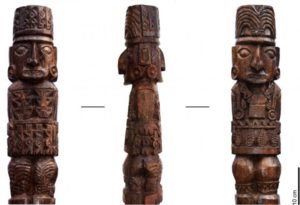
PLOS—The Pachacamac Idol of ancient Peru was a multicolored and emblematic sacred icon worshipped for almost 700 hundred years before Spanish conquest, according to a study* published January 15, 2020 in the open-access journal PLOS ONE by Marcela Sepúlveda of the University of Tarapacá, Chile and colleagues.
The Pachacamac Idol is a symbolically carved wooden statue known from the Pachacamac archaeological complex, the principal coastal Inca sanctuary 31 km south of Lima, Peru during the 15th-16th centuries. The idol was reportedly damaged in 1533 during Spanish conquest of the region, and details of its originality and antiquity have been unclear. Also unexplored has been the question of whether the idol was symbolically colored, a common practice in Old World Antiquity.
In this study, Sepúlveda and colleagues obtained a wood sample from the Pachacamac Idol for chemical analysis. Through carbon-dating, they were able to determine that the wood was cut and likely carved approximately 760-876 AD, during the Middle Horizon, suggesting the statue was worshipped for almost 700 years before Spanish conquest. Their analysis also identified chemical traces of three pigments that would have conferred red, yellow, and white coloration to the idol.
This nondestructive analysis not only confirms that the idol was painted, but also that it was polychromatic, displaying at least three colors and perhaps others not detected in this study. The fact that the red pigment used was cinnabar, a material not found in the local region, demonstrates economic and symbolic implications for the coloration of the statue. The authors point out that coloration is a rarely discussed factor in the symbolic, economic, and experiential importance of religious symbols of the pre-Columbian periods, and that more studies on the subject could illuminate unknown details of cultural practices of the Andean past in South America.
The authors add: “Here, polychromy of the so-called Pachacamac Idol is demonstrated, including the presence of cinnabar.”
____________________________

The wooden statue of the Pachacamac Idol. Sepúlveda et al, 2020.
____________________________
Article Source: PLOS news release
*Sepúlveda M, Pozzi-Escot D, Angeles Falcón R, Bermeo N, Lebon M, Moulhérat C, et al. (2020) Unraveling the polychromy and antiquity of the Pachacamac Idol, Pacific coast, Peru. PLoS ONE 15(1): e0226244.





